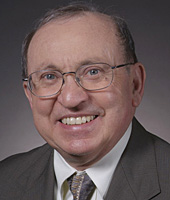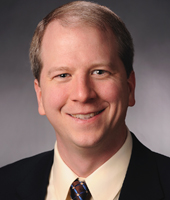AMES, Iowa -- A new Iowa State University/Gazette/KCRG poll of 333 likely Iowa Republican caucus goers finds Ron Paul in the top spot among GOP presidential candidates with 27.5 percent, followed closely by Newt Gingrich with 25.3 percent. Paul's lead over Gingrich is within the poll's margin of error at plus or minus 5 percentage points.
Mitt Romney is in third place at 17.5 percent, while Rick Perry is the only other candidate to poll in double digits at 11.2.
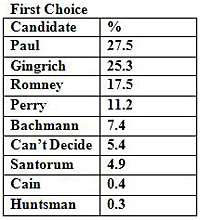
While Paul's lead is just over 2 percentage points and easily within the poll's margin of error, it may actually be more solid than it appears.
"What our poll says is that 51 percent of Paul's supporters say they're definitely backing him," said James McCormick, professor and chair of political science at Iowa State and coordinator of the poll. "The percentage for the next two candidates is much weaker, at 16.1 for Mitt Romney and 15.2 for Newt Gingrich. Moreover, the percentage of respondents 'leaning to' or 'still undecided' in their support for these latter two candidates remains high, at 58 percent for Gingrich and 38 percent for Romney. In other words, I'm going to make the case that these numbers are still very soft for those two candidates."
"I think Paul probably under-polls," said Dave Peterson, interim director of the Harkin Institute of Public Policy at Iowa State and associate professor of political science who assisted with the poll. "His supporters are younger and more likely to reply on a cell phone, so he's probably going to perform better than his polling suggests. His supporters also are dedicated and will likely turn out on caucus night and not change their minds."
With less than two week to go until the Jan. 3 Iowa Caucuses, the race still remains remarkably fluid. Asked how certain they were of their choice, 37.8 percent of respondents indicated that they were still trying to decide and another 34.1 percent answered that they were only leaning towards one candidate. Only 28.1 percent indicated that they had definitely decided who they would support.
"Because we surveyed the same likely caucus goers in November [data collected between Nov. 1 and 13], these results do indicate some movement to strengthening the commitment to a particular candidate," McCormick said. "In November, only 16.5 percent indicated that they had definitely committed to a candidate."
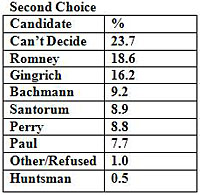
But with some uncertainty still in evidence among the poll respondents, their second choice may be critical to the outcome on caucus night. While "Can't Decide" was the most frequent answer (23.7 percent), Romney and Gingrich had double-digit support, with Michele Bachmann at just over 9 percent.
The new Iowa State University/Gazette/KCRG poll was compiled through phone interviews between Dec. 8 and 18, of 740 registered Republicans and 200 registered independents. Of those polled, 333 (35.4 percent) stated that they definitely or probably would attend the caucuses.
The new poll reflects the departure of Herman Cain from the field. Because the same individuals were surveyed in November and December, ISU pollsters can identify where the former Cain supporters have moved. The latest poll found that 38 percent of the former Cain supporters now select Gingrich as their first choice, with Paul getting 20 percent and Perry 14 percent. Romney received only 8.5 percent of those former Cain backers.
The new poll also compared the commitment among respondents to particular candidates from November to December. Although 67.3 percent of Romney's November supporters remain with him in the latest survey, 14.2 percent have moved to Perry and 10.3 percent to Gingrich. Among Perry's November supporters, 42.5 percent are now in the Gingrich camp. By contrast, Paul's supporters largely stayed in place with 83.8 percent of the November supporters also supporting him in December. Bachmann has also had a 78.1 percent retention rate.
The survey asked respondents to select the most important factor in motivating their support for a candidate. The most popular response was for a candidate who "takes strong stands" (32.0 percent), followed by a candidate who "can win the general election" (24.7 percent), and a candidate who "has the right experience" (24.4 percent). Paul did well on taking strong stances and the right experience, and even better on a fourth factor that he "cares about people."
"Ron Paul doesn't look like the typical presidential candidate," McCormick said. "I went over to his talk at the Memorial Union [Dec. 8] and heard him and he's sort of soft-spoken and not particularly strong on the stump. but his message is obviously connecting. Yeah he doesn't at all look like the typical presidential candidate, so he's the anti-Washington, anti-politician that he's trying to portray himself -- and it strikes a responsive chord among many people."
Gingrich did well on each of the three most frequently mentioned factors, but he did the best with the experience and electable factors. Romney scored best among the respondents on the experience and electable factors, although he was behind Gingrich on both of them.
Respondents also were asked to select from a list of 12 issues the most important one to them personally. "The economy and jobs" were selected by 35.1 percent of the respondents, followed by "the size and role of the federal government" (24.3 percent) and "national debt and the deficit" (21.5 percent). In all, 81 percent of the respondents identified one of these three issues as most important.
Among the top four candidates, there appears to be some differences by gender. Paul received much more support from women (31.7 percent) than men (22.3 percent), while Romney and Perry received more support from men than women, and Gingrich received about equal support from men and women. Among those undecided, support was equal across genders.
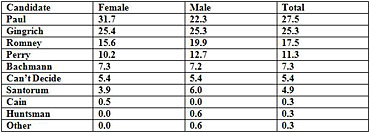
By income, Paul polled most support among those making $25,000 or less annually (50.0 percent), and those between $50,000 and $75,000 (43.5 percent). Gingrich did less well among the lowest income group (13.6 percent), but better among those earning $25,000 to $50,000 (25.0 percent). For those making $75,000 or more, Gingrich did especially well (37.9 percent). Romney's support came across all income levels, but he did not do well with the lowest income (less than $25,000). Perry's support was most concentrated in those making $50,000 or less.
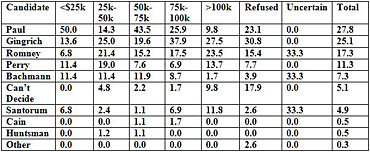
Notable differences in the level of support also existed by religion. Paul's greatest support came from those who identify themselves as "Born Again Protestants" (27.2 percent) and among those who report no religious preference (73.9 percent). Gingrich's most support came from Catholics (34.9 percent) and Born Again Protestants (28.3), and Protestants who identified themselves as not "born again" (26.4). Romney did best among Catholics (30.2 percent) and Protestants not born again (23.6 percent). Perry also did best among Protestants.
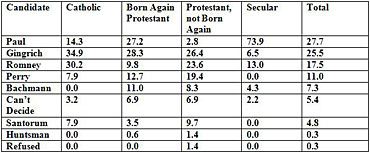
Paul, Gingrich, and Romney had different patterns of support based on the respondents' level of education. Paul's was particularly strong among those with a college degree (37.9 percent) or some post-graduate work (29.3 percent). By contrast, Gingrich's support was greatest among those with high school or less (29.5 percent) and some college (28.6 percent). Romney's support was strongest among those with some post-graduate work (32.8 percent).
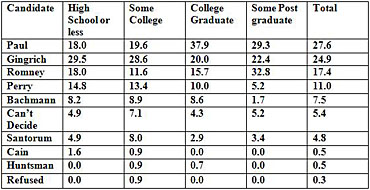
The Tea Party is expected to have an influence on the caucuses for the first time. Although only about a fifth of likely caucus attendees (17.4 percent) identified themselves as members of the Tea Party movement, 48.3 percent of respondents believe that the Tea Party will be a "major player" in the caucuses. Paul received the most support from non-Tea Party members (29.1 percent) -- the highest of any candidate -- and only 9.1 percent from Tea Party members, which tied for the lowest. Gingrich, by contrast, got the highest percentage of support from Tea Party members (42.4 percent) and the second highest support (22.3 percent) from non-Tea Party members. Romney got more support from non-Tea Party members than Tea Party members.
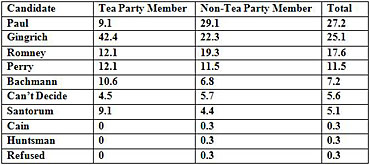
Age differences were apparent among supporters for the top three candidates. Paul gains support primarily from the young -- those under 44 years of age -- but did not do well among the middle-aged and elderly. He polled at over 50 percent among the 30-44 age group and 59.6 percent among those 18-29. Gingrich and Romney had the most support among those 45 and older, while Romney received 31.4 percent from those 65 and older.
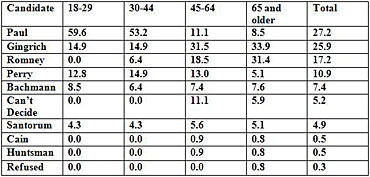
Paul attracted support across the ideological spectrum from those who identify themselves as extremely conservative to extremely liberal. The bulk of his support came from those who consider themselves "slightly conservative" and "moderate." Gingrich gained the most support from those identifying themselves as "extremely conservative" or "conservative." Romney's support was spread across the spectrum from "conservative" to "slightly liberal," with the most supporters among those who are "conservative," "slightly conservative," or "moderate." Perry had an ideological base similar to Romney, although with more "extremely conservative" support.
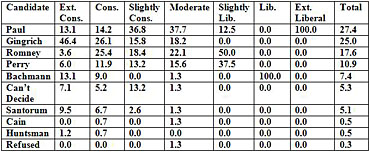
The Iowa State University/Gazette/KCRG Poll is supported by ISU's Department of Political Science, the Department of Statistics, the College of Liberal Arts and Sciences, the Carrie Chapman Catt Center for Women and Politics, the Office of Vice President for Research and Economic Development, and the Office of the Vice President for Student Affairs; as well as The Gazette and KCRG-TV9 in Cedar Rapids.
